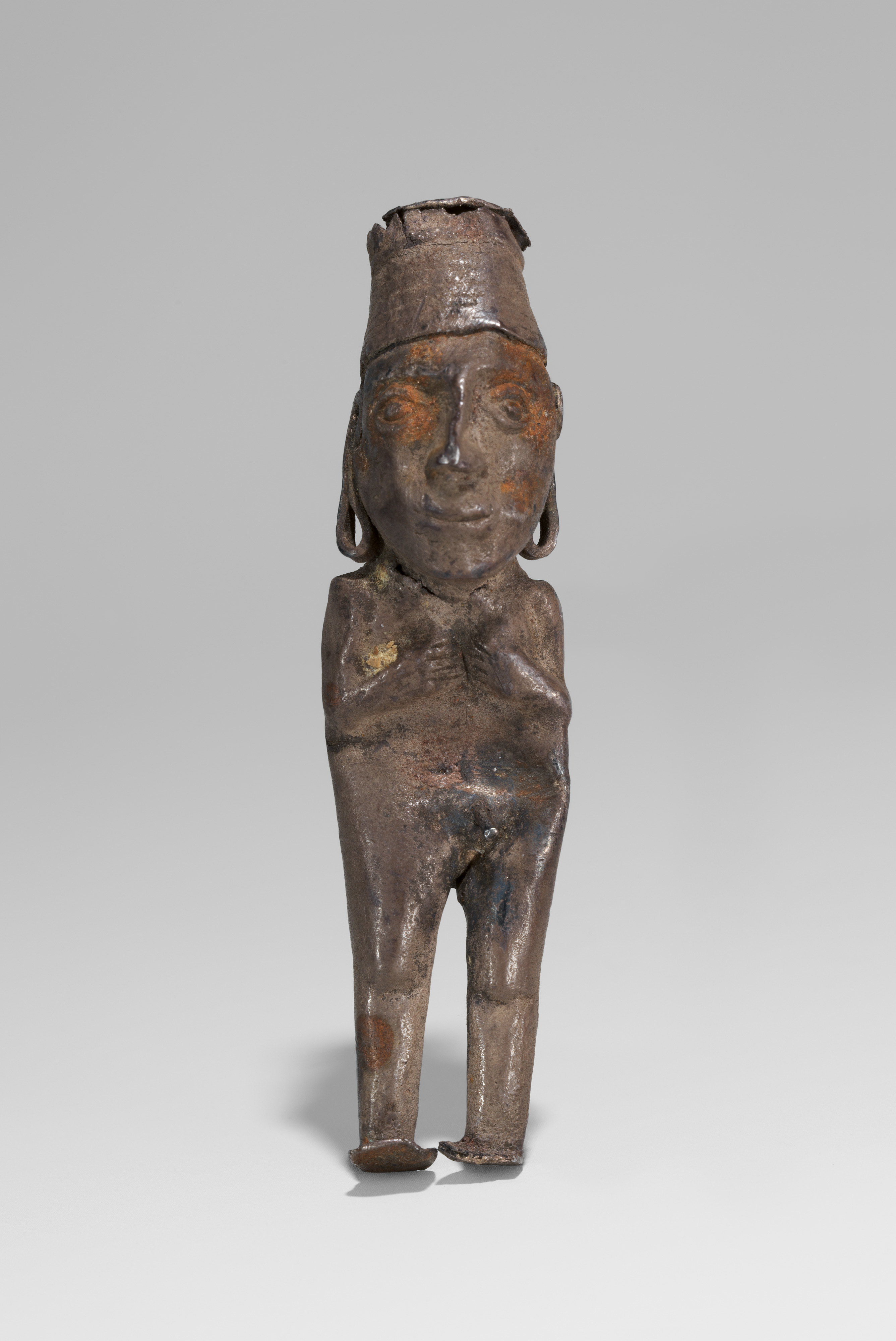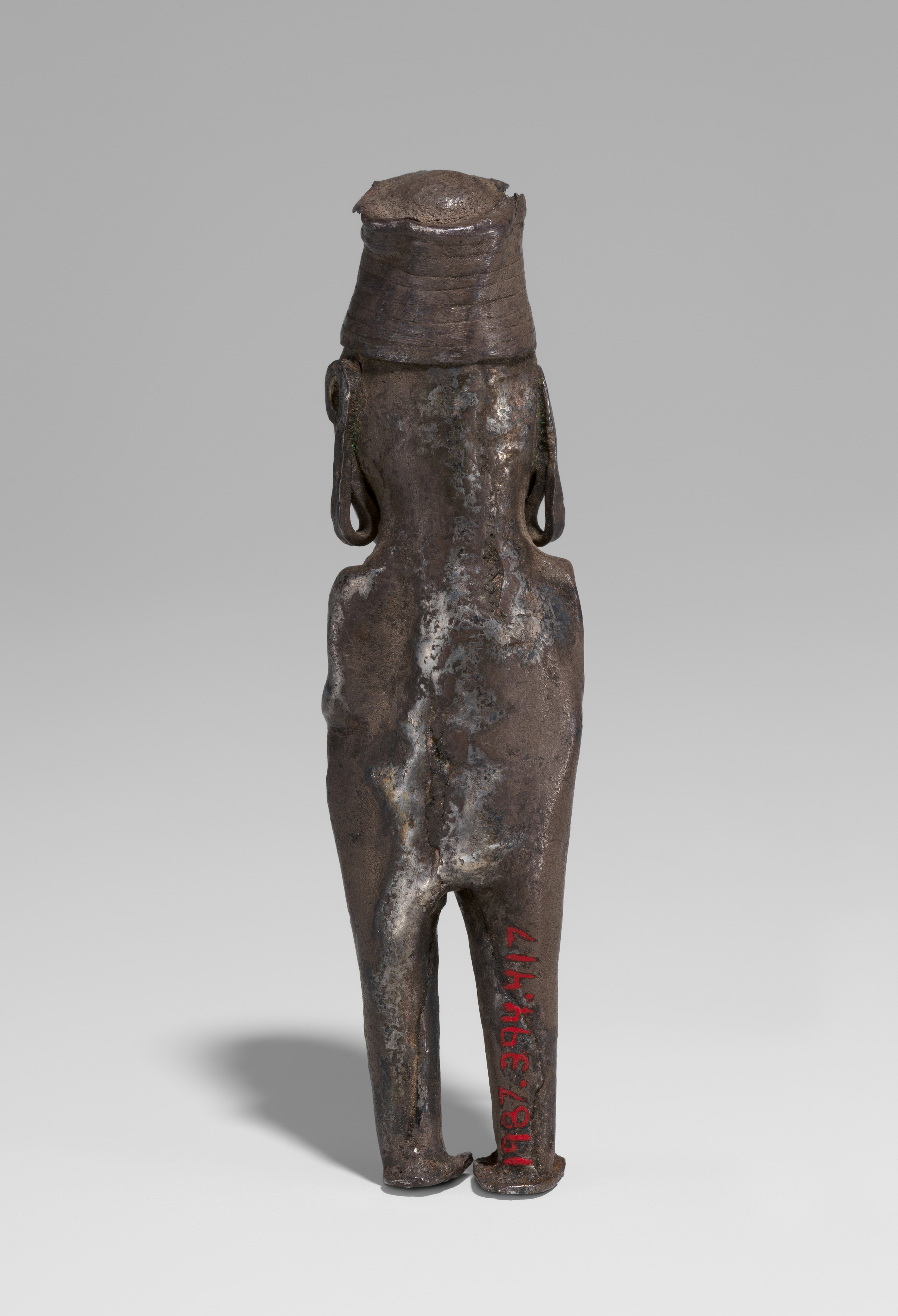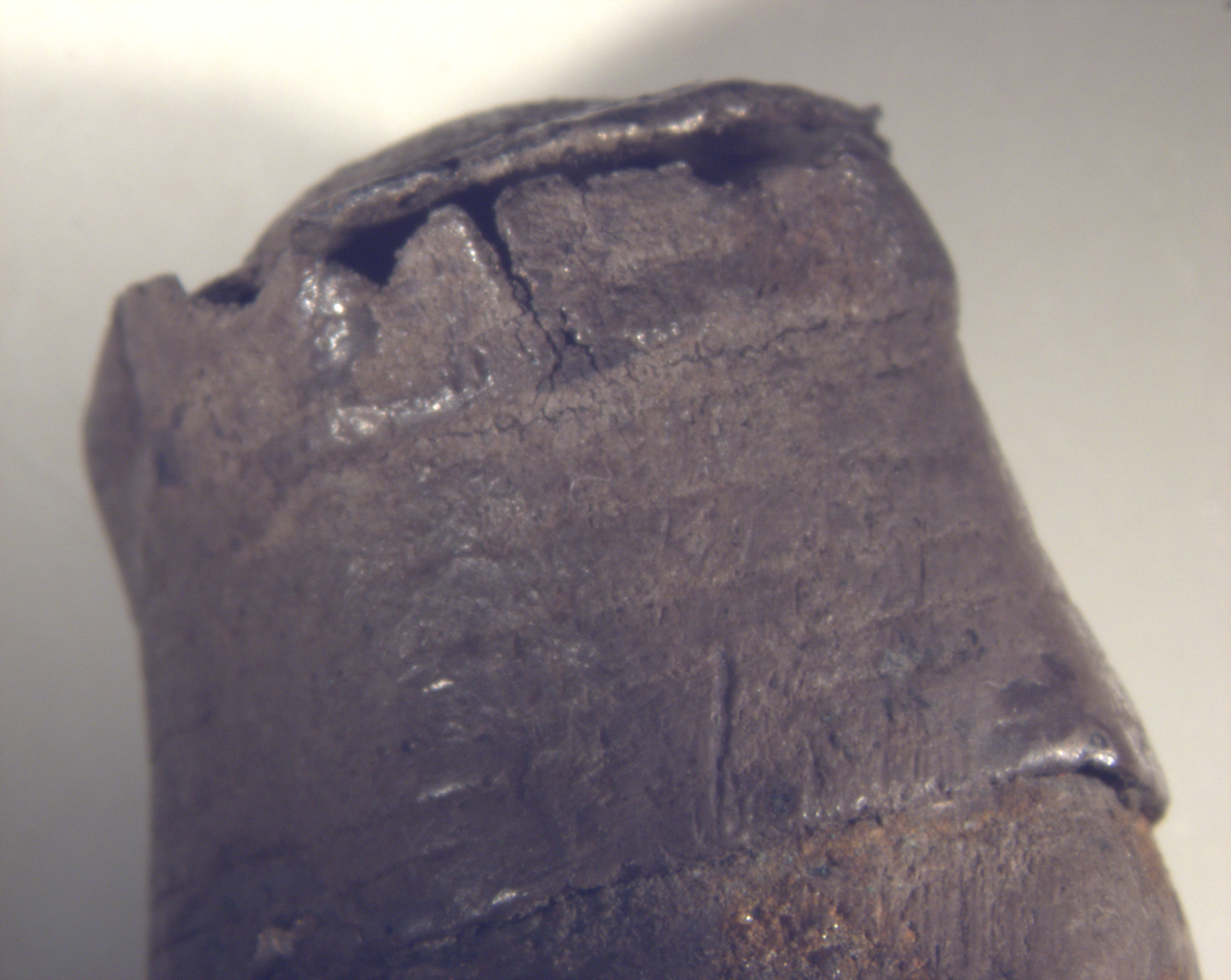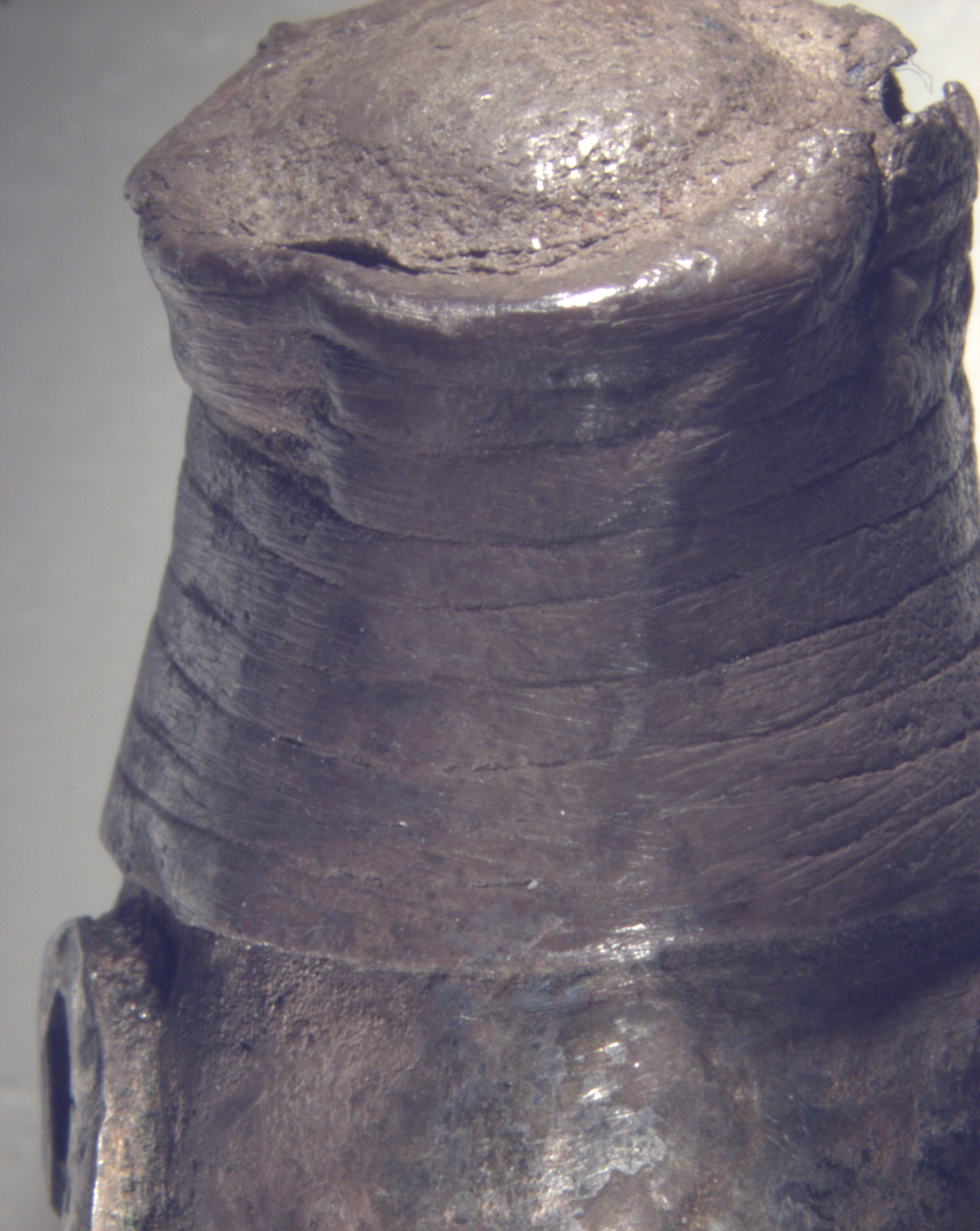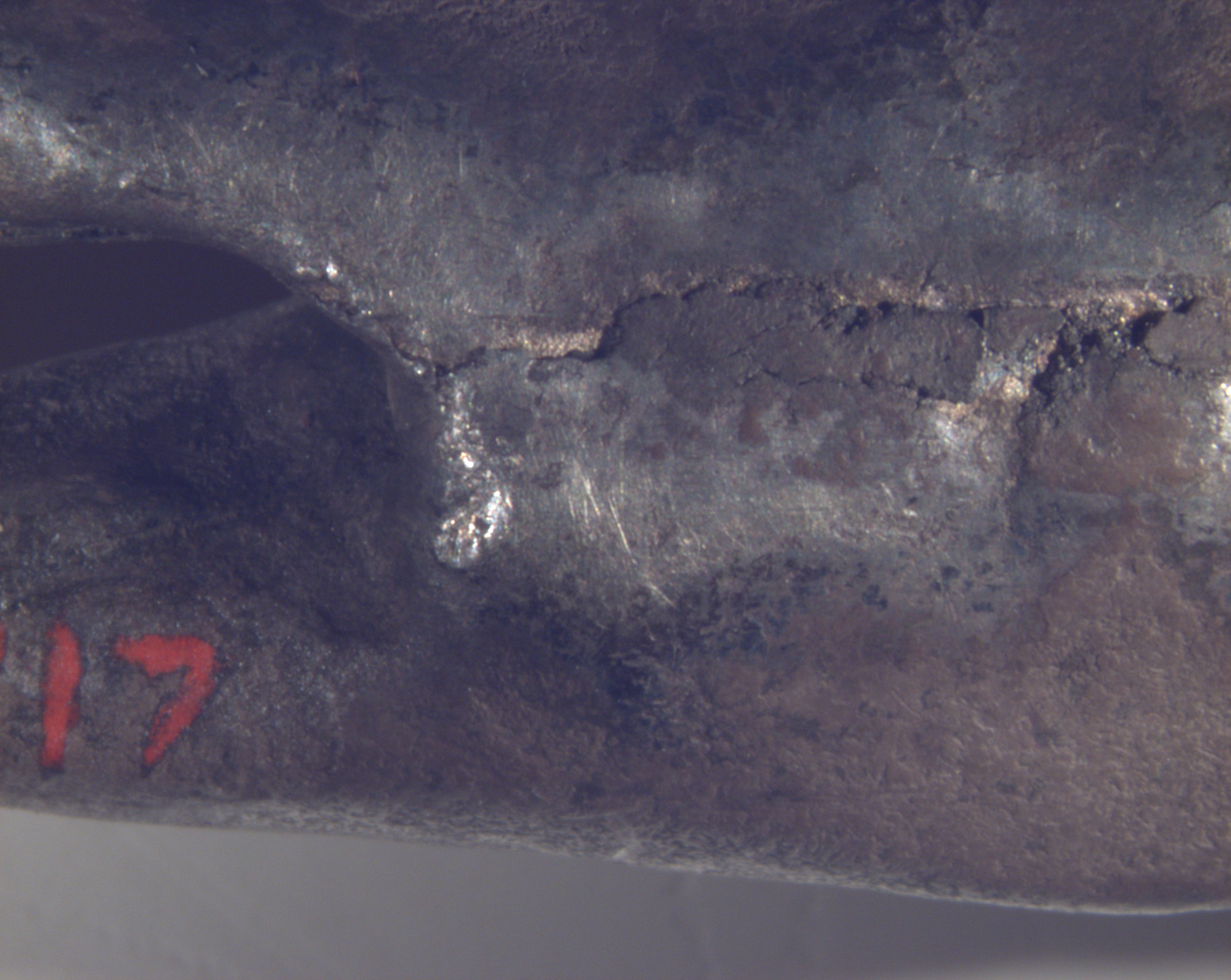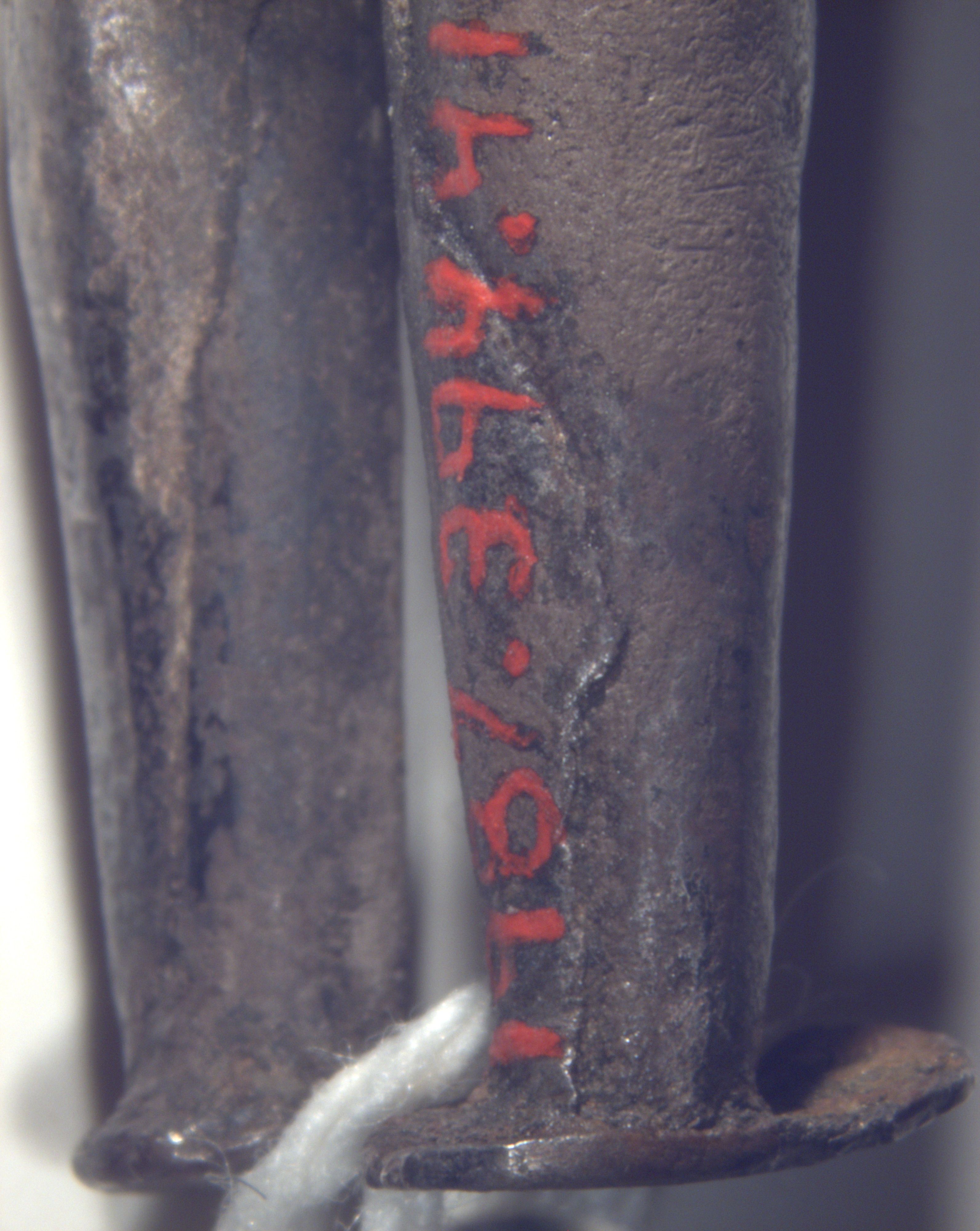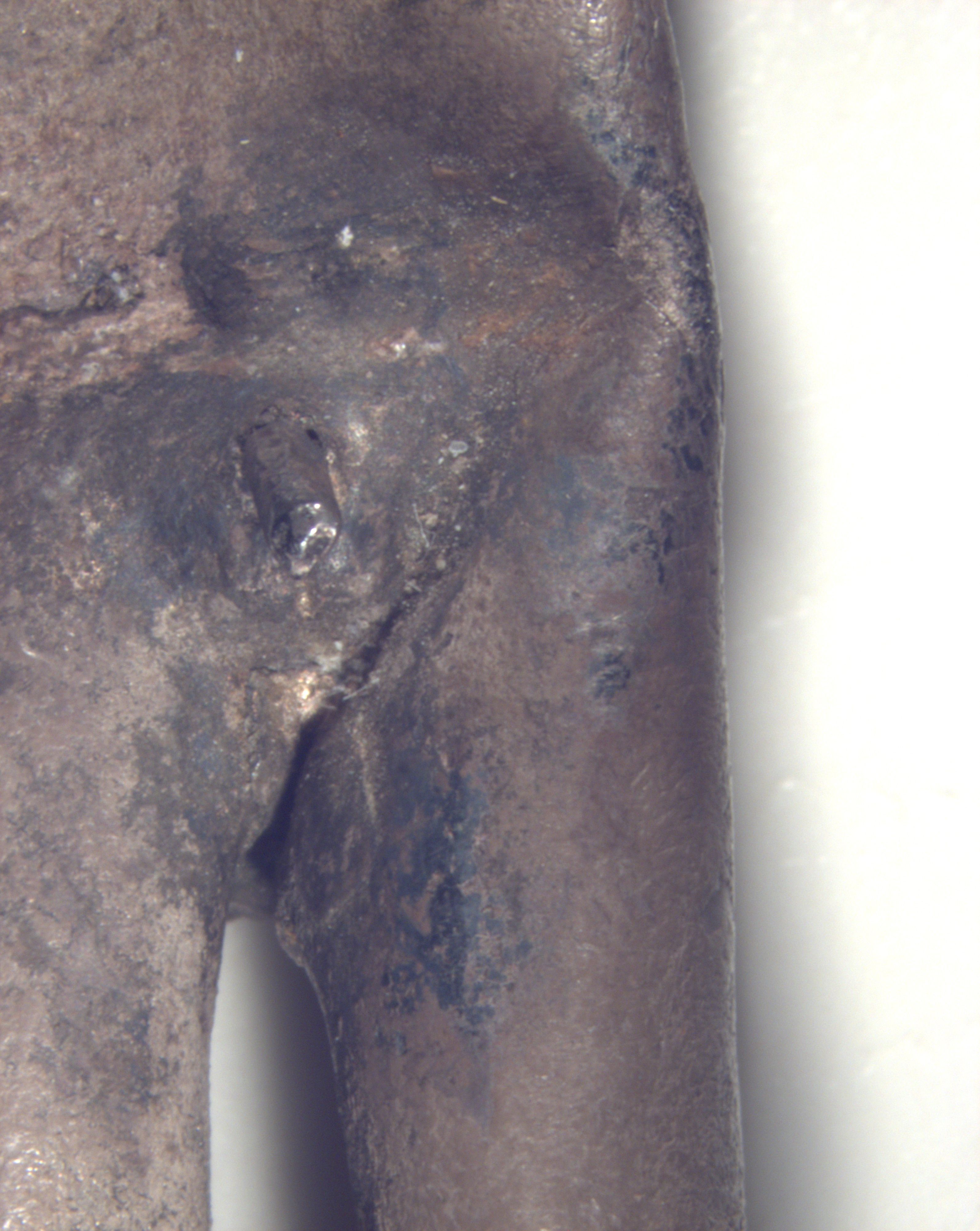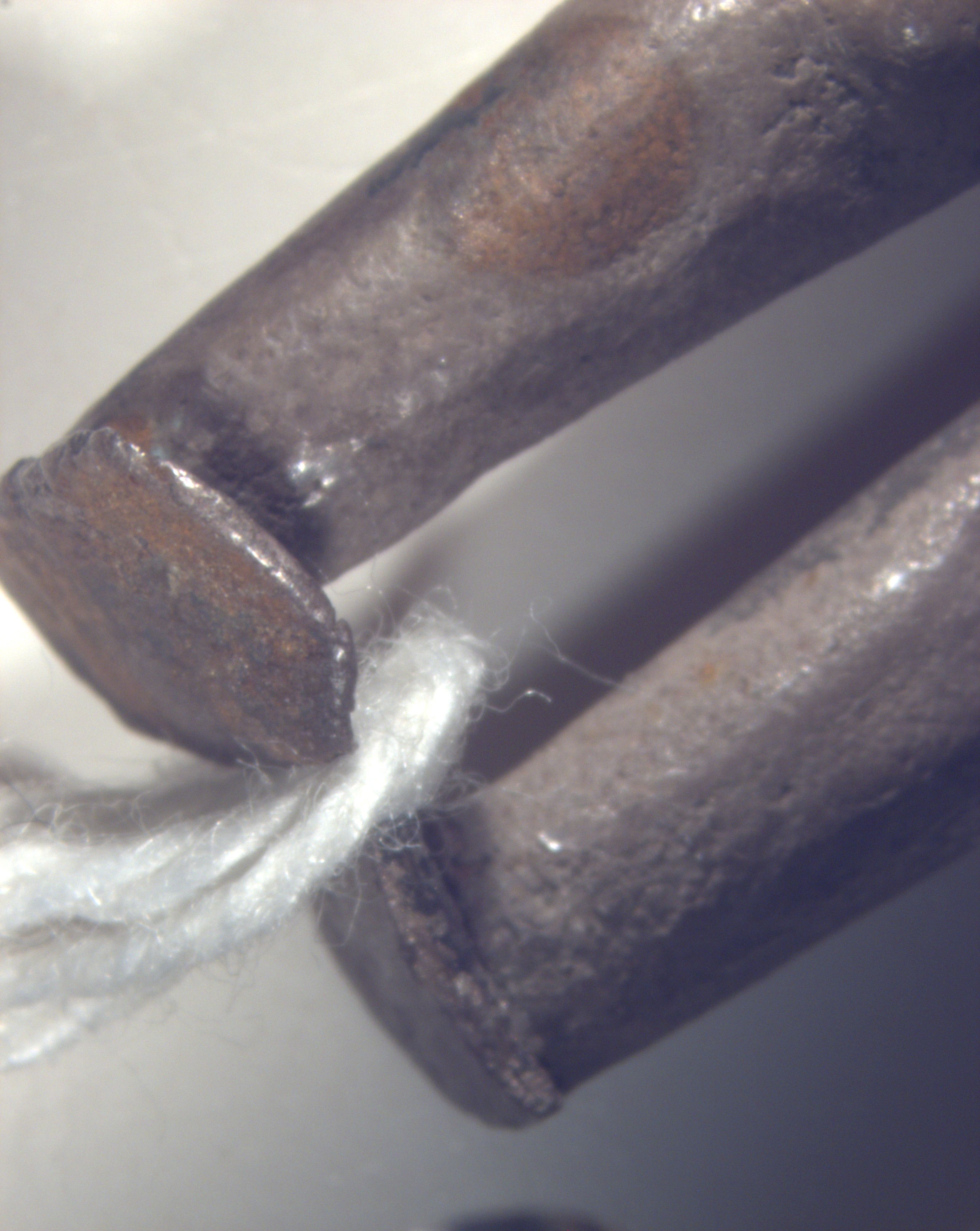Male Figurine
Not on view
This hollow figurine is comprised of eight pieces of metal sheet that have been joined together. It depicts a man standing upright, dressed only in a llautu, a braided headdress that was worn by the Inca ruler and nobles; otherwise, he is shown naked. The details of his eyes, nose, and mouth, along with extended earlobes that suggest they could have accommodated spools, and pose with arms and hands tucked into the chest, are all standard among Inca human male figurines made of metal. Furthermore, there is a quid of coca represented as a small, raised, circular region to the proper left of the mouth. The presence of this feature and its location is consistent among Inca male figurines in metal. Coca chewing and blowing is a process through which Andean peoples strengthened relationships with the natural environment and among themselves (Allen 2002).
These figurines are considered sacred beings, or huacas in the Quechua and Aymara languages, that may have been deposited as dedications. They are often associated with assemblages of materials interred as part of the Inca ritual performance of capac hucha, or ‘royal obligation’. This ceremony was defined by Spanish chronicler Cieza de León (1959, 190-193) as a practice of annual festivals in Cusco in which statues were brought from provincial regions to offer prophecies for the coming year. Cieza de León and Diez de Betzanos (1996, 46, 132) emphasize capac hucha as an assemblage of offerings made to commemorate sacred space or buildings or to mark certain royal events, such as the death of a ruler. Diez de Betanzos notes that, in some cases, children were ritually married in Cusco and then sent on processions to different locations the expanding Inca Empire where they were ultimately killed and buried with a range of offerings. There are archaeological sites in mountaintop, lowland, and coastal contexts that have been correlated with the descriptions of these depositions by Spanish chroniclers. Excavations have shown these depositions to include, besides remains of human children, miniature figurines in metal and Spondylus spp. dressed in textile garments and featherwork as well as ceramic and wooden vessels. However, some depositions of these figurines may not relate to the capac hucha. At the apacheta (or sacred shrine at the intersection of two paths) of Walla Walla, 194 km from Cuzco, a range of anthropomorphic and zoomorphic figurines were found standing vertically, wrapped in textiles made of vicuña wool tied with tupus (metal pins), inside a cut of a rock that itself was covered with a 3-4 meter deep layer of earth. Investigators interpreted the offering as a dedication to a female deity, mama rit’i, and not as a capac hucha assemblage (Valencia 1981, 51-52).
Of the three height groups (5-7 cm, 13-15 cm, 22-24 cm) among this corpus of Inca anthropomorphic figurines in metal, this figurine is in the smallest height group. As the x-rays suggest (see image 4), the metal components of this figurine include: the llautu; the two individual ears that are shown as stretched to allow for the insertion of plugs; the head, torso, and legs as one piece; the penis; and the two individual feet. The eighth component is a gusset of metal added to the genital region and visible to some extent on the proper left leg (cf. Lechtman 1996, fig. 108). To compare, a human male figurine made of gold sheet from Cerro Aconcagua, a capac hucha site with the burial of a 7-year-old human male in Argentina, is comprised of these same components, with the exception of two separate pieces for the cap and side of the llautu, a separate piece for the head, a distinct sheet for the testicles, and no mention of a gusset (Bárcena 2004).
Shorn of its specific cultural context, figurine 1987.394.417 likely would have been clothed and adorned—not to mention accompanied by a range of other offerings—in parallel with the depositions of similar figurines as parts of capac hucha assemblages throughout the Inca empire. At Choquepujio, near Cuzco, a male figurine, made of silver and 24 cm high, was recovered with a child burial along with several other smaller human male and camelid figurines made of Spondylus shell, gold, and silver (Gibaja et al. 2014). The representation of the llautu of the larger figurine is made of Spondylus and attached to its front there is a thin trapezoidal metal sheet—curved on its two long sides—called a canipu, an ornament assigned to individuals who were “Incas by privilege,” that is, they became Inca not by blood but by allying themselves with Inca leaders as they annexed new territories, expanding outwards from Cuzco (Mignone 2015). In the offering of the human male juvenile at Llullaillaco (MAAM 2007, 53; Mignone 2015, figs. 3-5)—a site considered sacred by the Kollas, who are Inca descendants—a canipu, having a small perforation for threading, was found attached to dyed woven fiber forming part of the llautu on a metal figurine, while another was found on a Spondylus figurine attached in a similar fashion. A third was found attached to the yaqolla, or mantle, wrapped around the body of a separate metal figurine. In the case of 1987.394.417, the llautu fits on top of the head, with slight overlap.
The llautu was raised from a single piece of metal and soldered to the top of the head (see image 5). It appears to have been decorated with traced lines but the silver corrosion from burial, covering most of the figurine, obscures the details (see image 6). Tracing was also used to indicate the toes. Soldering was the means used to achieve the seam on the back of the figurine. We can imagine that when the smith hammered the torso into roughly cylindrical shape (as part of the same piece with the head and legs), they encountered some difficulty: the left end of this sheet overlaps the right end closer to the head, while the right overlaps the left closer to the legs (see image 7). The penis is a separate piece, likely made of sheet, which was inserted into a perforation made in this region. As the metalsmith needed to close the torso cylinder by joining its two ends, thereby producing a seam, they also needed to close the cylindrical sheet that formed the legs. Parts of the leg seams are relatively inconspicuous to a viewer, found inside each leg, but the seams extend diagonally onto the more visible back of each leg (see image 8). The shaping and closing of the torso and legs—part of the same sheet—would have left a void in the crotch region. In other cases of these figurines, a gusset, or saddle-shaped patch of metal, has been identified, but here, the addition is not readily discernible by X-radiography (see images 4 and 9). Each foot is comprised of a single piece of metal onto which the ends of the leg have been soldered.
The figurine has not been cleaned to remove burial encrustation and corrosion. It also has been slightly crushed at some point in its history from a physical impact. There are dents on the front and back of the torso with cracks present across the neck and in the top of the llautu. This condition is a testament to the thinness of the metal sheet. The front part of the proper left foot is broken off and missing (see image 10).
In addition to incorporating practitioners of other Andean metalworking traditions, including Chimú and Chincha, into their network of production, the Incas wove in an array of different metal sources, geographically dispersed. Copper-tin was a hallmark of Inca metal production and the only Andean sources of cassiterite (tin oxide) are south and east of Cusco (Lechtman 2014). Copper—especially prevalent—along with gold and silver were found in the Central Andes, with silver in southern Bolivia and northern Argentina being a particular focus of Inca interest. As Lechtman (2007, 319) notes, while gold and silver are central to Inca hegemony, as they are related to the sun and moon, respectively, which played a role in the origins of the Inca people, copper also is a key feature of their metallurgical production. Most of the Inca human figurines in this corpus that have been analyzed tend to be composed of alloys of some or all of these metals, rather than monometallic.
Technical notes: Optical microscopy, X-radiography, and XRF conducted in 2017.
Bryan Cockrell, Curatorial Fellow, AAOA
Beth Edelstein, Associate Conservator, OCD
Ellen Howe, Conservator Emerita, OCD
Caitlin Mahony, Assistant Conservator, OCD
2017
References
Allen, Catherine J. The Hold Life Has: Coca and Cultural Identity in an Andean Community. Washington, D.C.: Smithsonian Institution Press, 2002.
Bárcena, J. Roberto, “Las piezas metálicas de la ofrenda ritual del Cerro Aconcagua, Mendoza, República de Argentina,” in Tecnología del oro antiguo: Europa y América, ed. Alicia Perea, Ignacio Montero and Óscar García-Vuelta (Madrid: Consejo Superior de Investigaciones Científicas, 2004), 157-172.
Cieza de León, Pedro de. The Incas. Edited by Victor Wolfgang von Hagen. Translated by Harriet de Onis. Norman: University of Oklahoma Press, [1553] 1959.
Diez de Betanzos, Juan. Narrative of the Incas. Translated and edited by Roland Hamilton and Dana Buchanan. Austin: University of Texas Press, [1551-57] 1996.
Gibaja Oviedo, Arminda M., Gordon F. McEwan, Melissa Chatfield, and Valerie Andrushko. “Informe de las posibles capacochas del asentamiento arqueológico de Choquepujio, Cusco, Perú.” Ñawpa Pacha 34, no. 2 (2014): 147-175.
Lechtman, Heather, “Technical Descriptions,” in Andean Art at Dumbarton Oaks, ed. Elizabeth Hill Boone (Washington, D.C.: Dumbarton Oaks Research Library and Collection, 1996).
———. “The Inka, and Andean Metallurgical Tradition.” In Variations in the Expression of Inka Power, edited by Richard L. Burger, Craig Morris, and Ramiro Matos Mendieta, 313- 355. Washington, D.C.: Dumbarton Oaks Research Library and Collection, 2007.
———. “Andean Metallurgy in Prehistory.” In Archaeometallurgy in Global Perspective: Methods and Syntheses, edited by Benjamin W. Roberts and Christopher P. Thornton, 329-359. New York: Springer.
Museo de Arqueología de Alta Montaña (MAAM). Museo de Arqueología de Alta Montaña. Buenos Aires: Fondo Nacional de las Artes, 2007.
Mignone, Pablo. “Illas y Allicac: La capacocha del Llullaillaco y los mecanismos de ascenso social de los ‘Inkas de privilegio.’” Boletín del Museo Chileno de Arte Precolombino 20, no. 2 (2015): 69-87.
Valencia Espinoza, Abraham, Metalurgia Inka: Los ídolos antropomorfos y su simbología. Cusco, 1981.
Due to rights restrictions, this image cannot be enlarged, viewed at full screen, or downloaded.
This artwork is meant to be viewed from right to left. Scroll left to view more.


